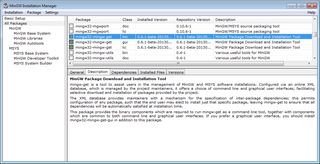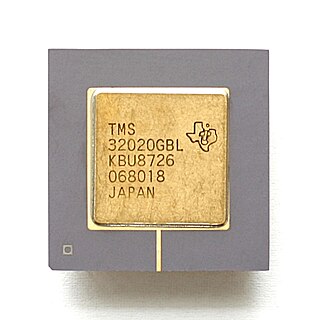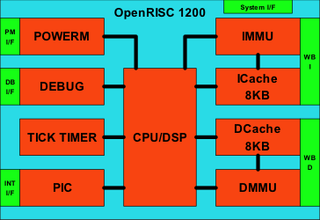
Cygwin is a Unix-like environment and command-line interface for Microsoft Windows.

Single instruction, multiple data (SIMD) is a type of parallel processing in Flynn's taxonomy. SIMD can be internal and it can be directly accessible through an instruction set architecture (ISA), but it should not be confused with an ISA. SIMD describes computers with multiple processing elements that perform the same operation on multiple data points simultaneously.

A digital signal processor (DSP) is a specialized microprocessor chip, with its architecture optimized for the operational needs of digital signal processing. DSPs are fabricated on metal–oxide–semiconductor (MOS) integrated circuit chips. They are widely used in audio signal processing, telecommunications, digital image processing, radar, sonar and speech recognition systems, and in common consumer electronic devices such as mobile phones, disk drives and high-definition television (HDTV) products.

MinGW, formerly mingw32, is a free and open source software development environment to create Microsoft Windows applications.

A coprocessor is a computer processor used to supplement the functions of the primary processor. Operations performed by the coprocessor may be floating-point arithmetic, graphics, signal processing, string processing, cryptography or I/O interfacing with peripheral devices. By offloading processor-intensive tasks from the main processor, coprocessors can accelerate system performance. Coprocessors allow a line of computers to be customized, so that customers who do not need the extra performance do not need to pay for it.
In computing, especially digital signal processing, the multiply–accumulate (MAC) or multiply-add (MAD) operation is a common step that computes the product of two numbers and adds that product to an accumulator. The hardware unit that performs the operation is known as a multiplier–accumulator ; the operation itself is also often called a MAC or a MAD operation. The MAC operation modifies an accumulator a:
OpenRISC is a project to develop a series of open-source hardware based central processing units (CPUs) on established reduced instruction set computer (RISC) principles. It includes an instruction set architecture (ISA) using an open-source license. It is the original flagship project of the OpenCores community.

The Blackfin is a family of 16-/32-bit microprocessors developed, manufactured and marketed by Analog Devices. The processors have built-in, fixed-point digital signal processor (DSP) functionality performed by 16-bit multiply–accumulates (MACs), accompanied on-chip by a microcontroller. It was designed for a unified low-power processor architecture that can run operating systems while simultaneously handling complex numeric tasks such as real-time H.264 video encoding.
Nios II is a 32-bit embedded processor architecture designed specifically for the Altera family of field-programmable gate array (FPGA) integrated circuits. Nios II incorporates many enhancements over the original Nios architecture, making it more suitable for a wider range of embedded computing applications, from digital signal processing (DSP) to system-control.

TMS320 is a blanket name for a series of digital signal processors (DSPs) from Texas Instruments. It was introduced on April 8, 1983 through the TMS32010 processor, which was then the fastest DSP on the market.
TriCore is a 32-bit microcontroller architecture from Infineon. It unites the elements of a RISC processor core, a microcontroller and a DSP in one chip package.

A multi-core processor is a microprocessor on a single integrated circuit with two or more separate processing units, called cores, each of which reads and executes program instructions. The instructions are ordinary CPU instructions but the single processor can run instructions on separate cores at the same time, increasing overall speed for programs that support multithreading or other parallel computing techniques. Manufacturers typically integrate the cores onto a single integrated circuit die or onto multiple dies in a single chip package. The microprocessors currently used in almost all personal computers are multi-core.

The Parallax P8X32A Propeller is a multi-core processor parallel computer architecture microcontroller chip with eight 32-bit reduced instruction set computer (RISC) central processing unit (CPU) cores. Introduced in 2006, it is designed and sold by Parallax, Inc.
A modified Harvard architecture is a variation of the Harvard computer architecture that, unlike the pure Harvard architecture, allows memory that contains instructions to be accessed as data. Most modern computers that are documented as Harvard architecture are, in fact, modified Harvard architecture.

Tensilica Inc. was a company based in Silicon Valley in the semiconductor intellectual property core business. It is now a part of Cadence Design Systems.
Stream Processors, Inc. (SPI), was a Silicon Valley-based fabless semiconductor company specializing in the design and manufacture of high-performance digital signal processors for applications including video surveillance, multi-function printers and video conferencing. The company ceased operations in 2009.

The OpenRISC 1200 (OR1200) is an implementation of the open source OpenRISC 1000 RISC architecture.
Heterogeneous System Architecture (HSA) is a cross-vendor set of specifications that allow for the integration of central processing units and graphics processors on the same bus, with shared memory and tasks. The HSA is being developed by the HSA Foundation, which includes AMD and ARM. The platform's stated aim is to reduce communication latency between CPUs, GPUs and other compute devices, and make these various devices more compatible from a programmer's perspective, relieving the programmer of the task of planning the moving of data between devices' disjoint memories.
The Pixel Visual Core (PVC) is a series of ARM-based system in package (SiP) image processors designed by Google. The PVC is a fully programmable image, vision and AI multi-core domain-specific architecture (DSA) for mobile devices and in future for IoT. It first appeared in the Google Pixel 2 and 2 XL which were introduced on October 19, 2017. It has also appeared in the Google Pixel 3 and 3 XL. Starting with the Pixel 4, this chip was replaced with the Pixel Neural Core.










